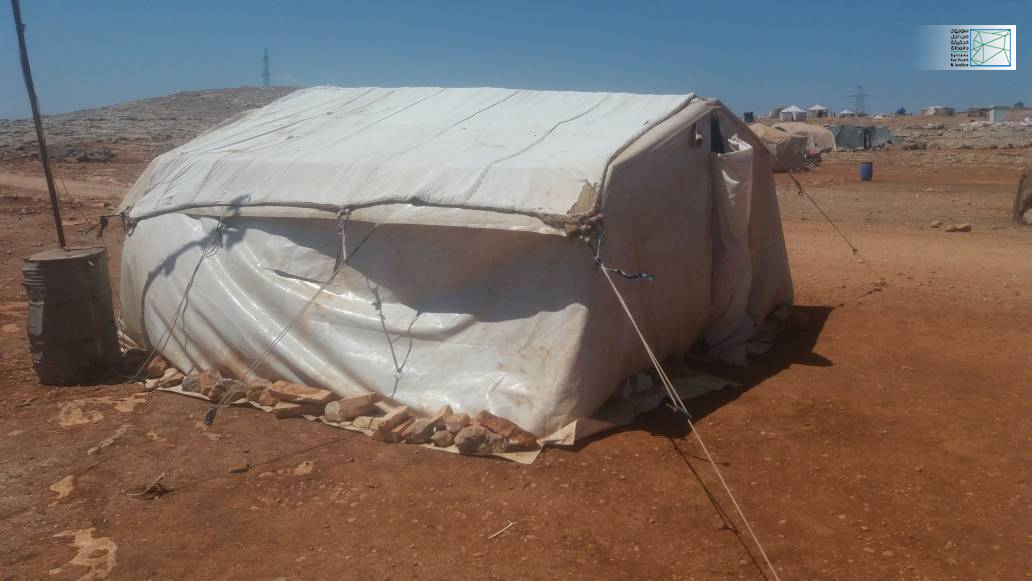Preface Thousands of IDPs crowded makeshift camps in rural Ma`arat al-Nu`man, as they fled Damascus, Homs, Hama and Daraa as a result of military operations. All of the 13 camps residents there, continue to suffer and their life get tougher day after day, since they lack basic human needs such as safe water, medical care, and education, and the situation get worse as the winter approaches.
According to STJ field researcher, 15, 000 people fled the eastern countryside of Hama to these camps as a result of the fighting between the armed opposition factions and the Syrian regular forces, which led to the latter’s control over the area in 2017, and caused a significant population displacement towards Idlib southern countryside, especially to rural Ma`arat al-Nu`man. Children, however are the worst affected, where a large number of them were diagnosed with “leishmaniasis”[1] due to the absence of any health center within these camps, as well as the cease of food aid entry to the camps from several months ago, and the fact that they were forced to stay in torn uninhabitable tents, according to STJ’s field researcher.
STJ had earlier prepared a report[2] on the deplorable humanitarian conditions of 250.000 IDPs from Hama eastern countryside, following their mass exodus to makeshift camps in Idlib governorate as a result of the military campaign launched by the Syrian regular forces and their allies, which resulted in their control over the area by the end of 2017.
First: catastrophic humanitarian situations
“Ahmed Mustafa al-Zilal”, an elderly IDP living in the "al-Tali'ah Camp", located in rural Ma`arat al-Nu`man, southern Idlib, said that he used to earn living for his 10 members family from the bounties of the sheep he owned before being forced to flee his village in the eastern countryside Hama to the "al-Tali'ah Camp", as a result of heavy shelling on the area by the Syrian regular forces. Alhaji "Ahmed" is currently living with his family in a small miserable tent. Regarding this, he recounted to STJ saying:
“I ended up here, after I was a merchant and a breeder of a large number of cattle, I’m living now with my 10 members family in a torn uninhabitable tent, which is prone to collapse at anytime, as I have no money to change it, and things will get worse in the approaching winter. The situation of people living here in the camp can be shortened by several words, "they are suffering heat and hunger, in addition to the acute shortages of basic necessities." As there are no schools or medical centers in the camps, where the medics made mere tours between tents every other time to provide vaccines. We suffer primarily from the explosion of many epidemics, where two of my sons, 13 and 6 years old, have been infected with "measles"[3], and I was forced to took the in the medical center, since there is none in the camp, not to mention the unemployment that is prevalent among youth in the camps, which has significantly worsened the financial situation of the camp residents.”
"Ahmed" was obliged to sell all of his livestock at low prices, so that he could provide a living for his family, especially since food aid had long been ceased, and food prices were very high, which most of the camp population could not afford, and endure all these sufferings, "Ahmed" said:
"We actually do not know if our situation would get better or would stay like this, suffering. Until then I can only appeal to all organizations and institutions concerned to take mercy on us, IDPs living here in the camps south of Idlib and help us live a dignified life. All we want is to live as humans.”
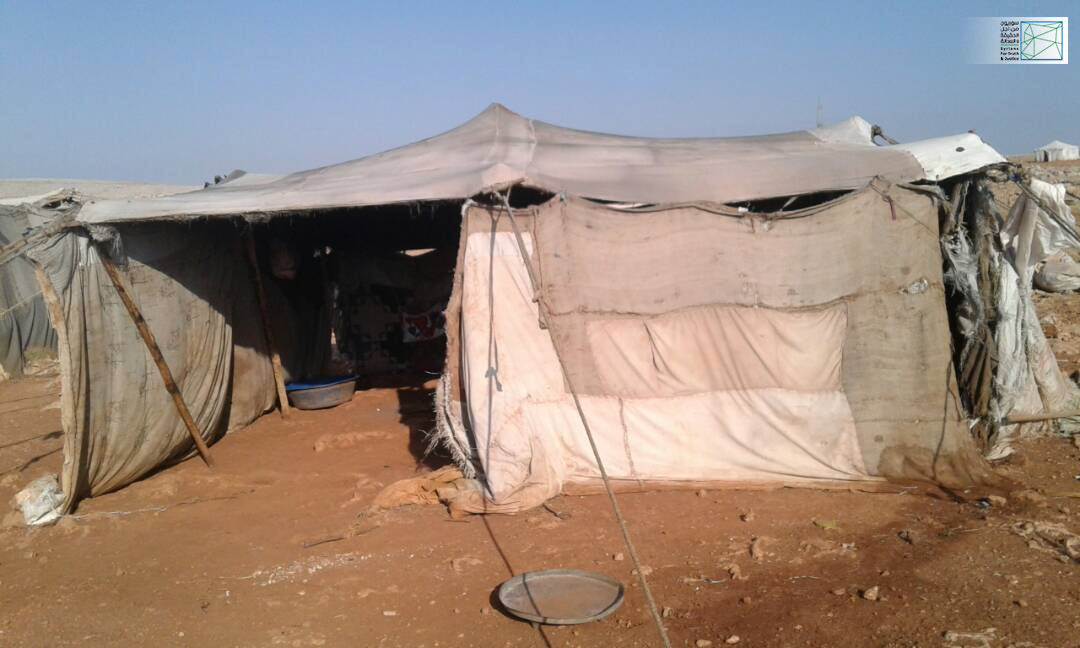
A side of a refugee camp in rural Ma`arat al-Nu`man, southern Idlib. Taken during August 2018.
Second: a complete cessation of food aid and the absence of sponsoring organizations and bodies
"Muhammad al-Hussein", another IDP resides in the "al-Tali'ah Camp", he was born in the town of "al-Fanat", Eastern Hama (1983). "Muhammad" was a teacher at a primary school in his hometown. On July 17, 2012, agents affiliated to Syrian regular forces abducted him for about 24 hours, during which he was tortured. All because of his opposition to the Syrian regular forces’ practices. After his release, he decided to flee to Samiriyeh village eastern Hama, where he settled for five years, and by the end of 2017, "Muhammad" was displaced with his 4 members family to "al-Tali'ah camp" in rural Ma`arat al-Nu`man. In this regard, he spoke to STJ, saying:
"We were left here suffering miserable living conditions, where the tents are uninhabitable and can’t shelter us from the cold and rain of the approaching winter, moreover, no services are provided in the camp, where many harmful insects spread in summer, in addition to the poor sanitation in the camp and the lack of potable water, where only 100 barrels of water be brought for more than 200 families living within the camp. The dirt roads between tents need paving and resurfacing as they are very poor and turn to mud as a result of rain, which makes it very hard to walk down them. As for the health situation, there are vaccine campaigns to combat certain diseases, but if we need to treat a child or a woman we have to travel a very long way up to 15 km, to receive treatment at a medical center in one of the neighboring towns. I have been living for about 8 months with my 4 members family and my father, my mother and stepmother in one tent, which was been left by one of the camp residents after it was torn and no longer usable and housed, since we are poor and couldn’t buy a new one, so we were forced to stay in it after we did some fixes.”
"Muhammad" said that the IDPs suffering from a complete cessation of foodstuffs, that the last time one organization had distributed food baskets was from about three months or more, and that the phenomenon of unemployment was widening each day due to the increased number of IDPs and the absence of sponsoring and concerned organizations, he continued, saying:
"The majority of the people who were displaced to "al-Tali'ah Camp" had sold everything they had after leaving their hometowns, such as sheep and cows and everything they had been able to take, at very low prices, because of the exploitation exerted on them by some mean-spirited people. The humanitarian situation in the camp get worse day after day.”
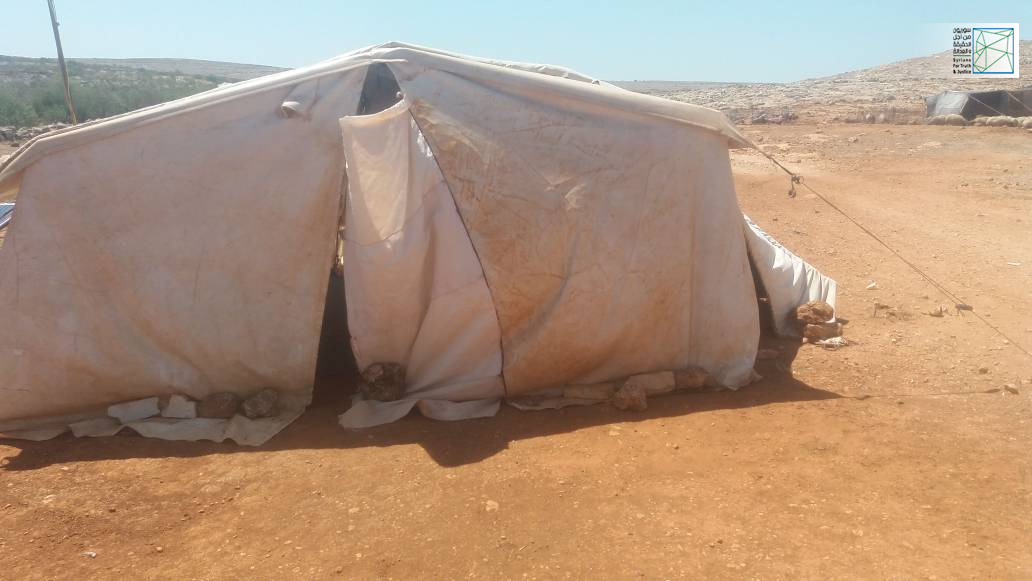
A side of a refugee camp in rural Ma`arat al-Nu`man, southern Idlib. Taken during August 2018.
Third: Fears from the approaching winter
Al-Tali'ah Camp is one of the 13 camps scattered in rural Ma`arat al-Nu`man, southern Idlib. The inhabitants of these camps are suffering from very difficult humanitarian conditions, as confirmed by "Khaled al-Howaian", one of the officials of those camps, who told STJ that after the "forcible displacement" of the people from the southern governorates of Syria towards rural Ma`arat al-Nu`man, the situation has worsened in the camps, since they couldn’t house such large numbers of IDPs, in the absence of humanitarian organizations and bodies concerned. He also mentioned the poor service, especially the medical and educational, and the most serious matter, which is the outbreak of infectious diseases among the camp population, speaking in this regard:
"There are 13 camps in rural Ma`arat al-Nu`man, southern Idlib, they are: al-Tali'ah Camp, al-Fedaa Camp, al-Naoura Camp, Benen Camp, Norias Camp, Eastern Kafar Roma Camp, al-A’mam Camp, Souq al-Ghanam Camp, Maar Shamshah Camp, Babeela Camp, Ma'saran camp, Hersh Ad Dana Camp, and Eastern Ad Dana Camp, each inhabited by approximately 600 to 900 people, knowing that IDPs from the eastern countryside Hama are around 90% of the overall IDPs living in those camps, who are suffering poor living conditions, which get worse as winter approaches, which portends untold tragedies for the camps residents, due to the floods that cause damage to the tents and make them often collapse, forcing people living in them to search for another shelter or to stay in the open.”
"Al-Howaian" said that the camps, which are scattered in rural Ma`arat al-Nu`man, lack the basic necessities of life. From a health standpoint, many diseases have spread among the camp population because of the bad odors and contamination caused by the sanitation pipes being on the ground level, pointing to an increase in the incidence of "leishmaniasis" among IDPs in those camps, especially children, he also said that what makes it worse the lack of a fixed medical center within the camps, as there are only transient visits to some medical mission besides intermittent and long-term vaccination campaigns. In terms of living services, during winter and because the camp has a dirt ground, the rainfall cause floods which seriously damage the tents, and impedes the movement of camp residents. He said that the sanitation need to be fully re-maintained and repaired as a matter of urgency, as it poses the greatest danger to the camp population, and he continued:
"In addition to the above mentioned, residents of these camps suffer also from a scarcity of potable water, poverty, lack of food, and severe shortage of basic materials, where each tent houses two families, and it should be noted that the camps have not received any food assistance since the beginning of March 2018. For the educational situation, there are no schools in or near the camps, which have made hundreds of children illiterate, and thereby their future at stake. In 2017, some teachers from these camps volunteered to teach children despite the very limited resources, as they used to teach children in small tents using simple tools. This year however, no teaching initiatives have been took so far.”
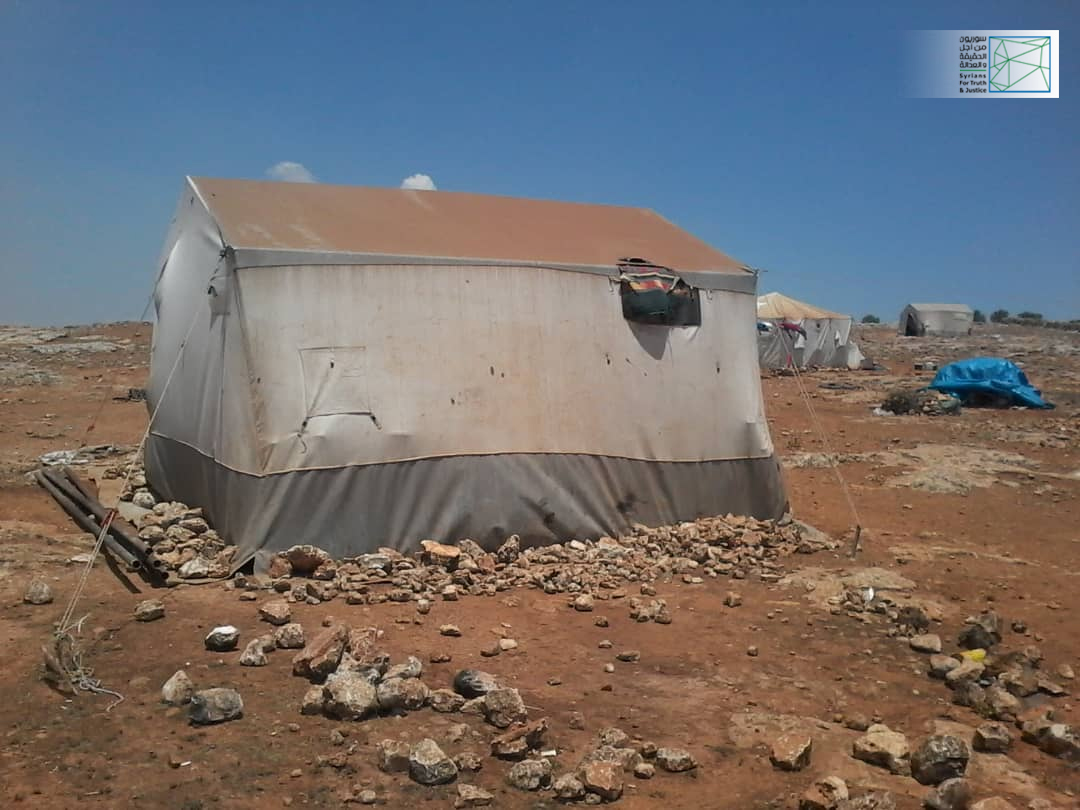
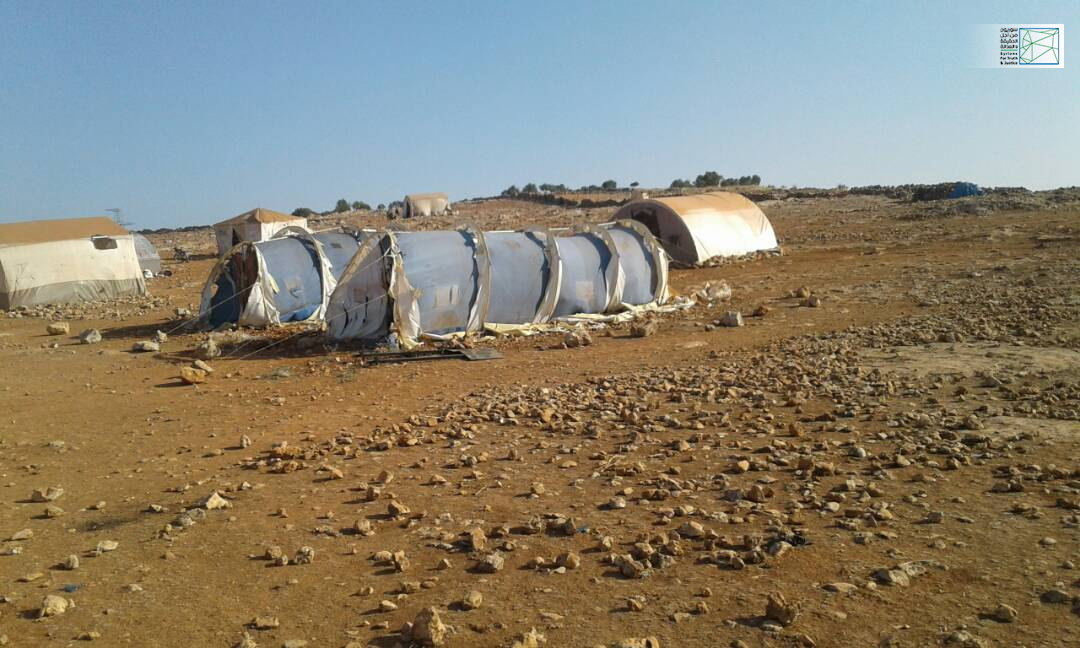
A side of a refugee camp in rural Ma`arat al-Nu`man, southern Idlib
Taken during August 2018.
Fourth: Lack of medical care
"Muhammad al-Ali", a doctor working in rural Ma`arat al-Nu`man, also made a statement to STJ saying that many skin and internal diseases had begun to spread among the IDPs, because there is no medical center in any of the (13) camps there, in addition to the indifference of the organizations, associations and bodies sponsoring the issue of IDPs. In this regard, he continued:
"Diseases continue to appear and spread rapidly among IDPs in these camps, including the" leishmaniasis”, “measles”, "diarrhoea" and "Enteritis", all of which caused by pollution, resulted from the poor services, such as the cracked sanitation pipes, lack of water and detergent in addition to the spread of harmful insects. Leishmaniasis is the most common and prevalent diseases in the camps, which mostly affects children, in the lack of fixed medical centers which should provide people with periodic vaccines against this disease. The nearest medical point from the camps is about 15 km away, and the last time the children were provided with vaccines against "Leishmaniasis" was at the end of April 2018. Residents of those camps are also suffering from a severe shortage of most of the medications to treat other disease. The establishment of a medical center, equipped with modern medical equipment and provided with medication for measles and Leishmaniasis and others, would resolve the health care issue within these camps.”
"Ayad Abu al-Jood", a media man from rural Ma`arat al-Nu`man, told STJ that the total population of those camps was about 12,000, mostly from villages and towns of eastern Hama who had been forced, by war conditions, to accept the camps’ deteriorating humanitarian situation, adding:
“IDPs’ situation in those camps isn’t be covered by media because of their location southern Idlib, where almost all media outlets placing heavy coverage on the camps on the Syrian-Turkish border, forgetting that many of the camps inside the Syrian liberated areas need a strong and vigorous effort to shed light on the suffering of their residence, and what has made it more complex is the fled of thousands civilians from Damascus, rural Homs, southern Hama and, lately, from Daraa, which was a part of a policy of demographic change followed by the Syrian regime and its allies.
It should be noted that the eastern areas of rural Hama, from where the IDPs had fled, were held by both ISIL and some other armed opposition factions before the heaviest military campaign was launched on it by the Syrian regular forces in 2017, where fierce battles were being waged between the Syrian regular forces on the one hand and ISIL, which had controlled most of the countryside areas, such as villages and towns of Al-Hamraa Subdistrict. These battles resulted in the removal of ISIL from the area to be controlled by the Syrian regular forces, after which another campaign was launched by the Syrian forces against armed opposition factions that also retreated to the progress of the Syrian regular forces under a Russian air force cover and an intensified shelling.”
[1] Mainly, as a vector-borne disease through bite of infective female phlebotomines (sandflies). L. major is transmitted by Phlebotomus papatasi from the animal reservoir to humans. L. tropica is transmitted by P. sergenti from person to person.Very rarely, L.tropica through transfusion.
[2] “Deplorable Humanitarian Conditions in Random Camps for Displaced Persons from Eastern Countryside of Hama”, published on July 24, 2018. https://www.stj-sy.org/en/view/644
[3] Measles is a highly contagious respiratory infection that's caused by a virus that infects only humans. It is transmitted by respiratory droplets and direct contact with nasal or throat secretions of infected persons. The incubation period of measles ranges between 7 and 18 days and patients are infectious from about 4 days before developing the rash until 4 days after rash. The illness is presented by high fever, generalized rash, and cough, coryza (runny nose) or conjunctivitis (red eyes). Complications of measles include viral and bacterial pneumonias and severe diarrhoea. The disease can also lead to lifelong disabilities including brain damage, blindness and deafness.
For more info, please visit: http://www.emro.who.int/health-topics/measles/disease-and-epidemiology.html


